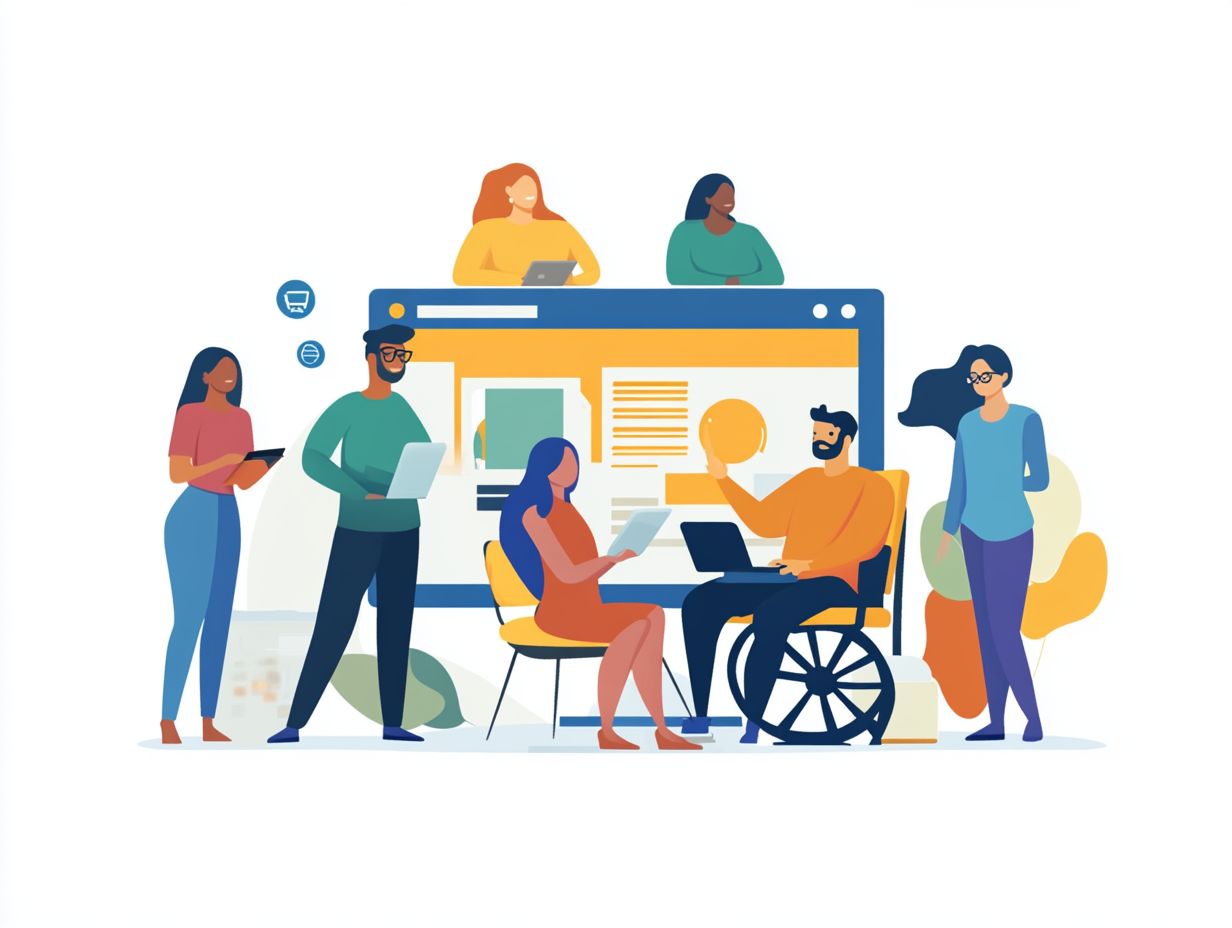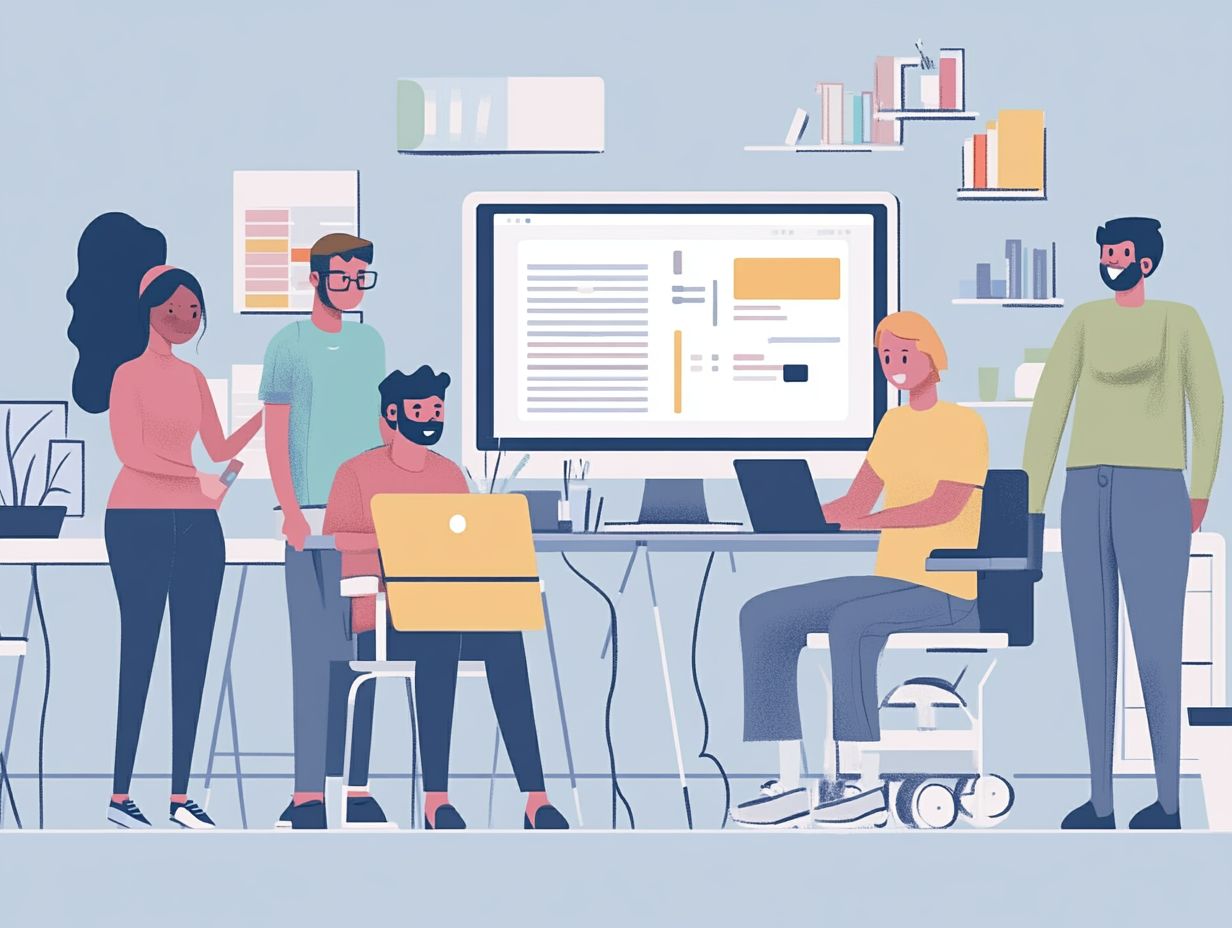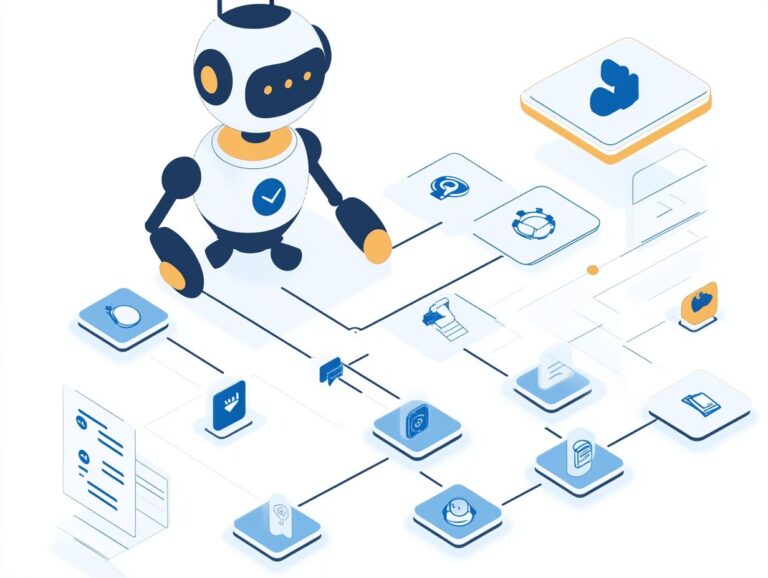AI Solutions for Improving Website Accessibility
In today’s digital landscape, ensuring that your website is accessible to everyone is more important than ever.
Innovative solutions are revolutionizing the way you approach website accessibility. With tools like automated captioning and voice recognition technology, navigating online spaces is becoming significantly easier for individuals with disabilities.
This article delves into the various ways technology can enhance website accessibility, the benefits of implementing these solutions, and practical steps you can take as a website owner.
Explore with us how these advancements can foster a more inclusive online experience for all users.
Contents
- How Can AI Help Improve Website Accessibility?
- What are the Benefits of Implementing AI Solutions for Website Accessibility?
- How Can Website Owners Implement AI Solutions for Accessibility?
- Frequently Asked Questions
- What are AI solutions for improving website accessibility?
- How can AI improve website accessibility?
- What are the benefits of using AI for website accessibility?
- Are there any challenges to implementing AI solutions for website accessibility?
- Can AI solutions for improving website accessibility be customized?
- How can businesses ensure their website is accessible for all users?
How Can AI Help Improve Website Accessibility?

In today’s digital landscape, enhancing website accessibility is essential for allowing all users, including those with visual impairments and cognitive disabilities, to navigate online spaces with ease.
You have the opportunity to harness AI-driven solutions that can transform traditional web development practices into inclusive technology frameworks. By integrating AI technologies like machine learning, neural networks, and automated testing, you can create adaptive content that aligns with the Web Content Accessibility Guidelines (WCAG).
These enhancements not only expand digital inclusion but also dramatically elevate the user experience and engagement across a range of platforms and devices.
1. Automated Captioning and Transcription Tools
Automated captioning and transcription tools are essential for you to make web content accessible, especially for users with hearing impairments and those who prefer visual aids while consuming audio material.
These technologies not only elevate user experience but also broaden your audience’s engagement with online content. Tools like Google s Live Transcribe and Microsoft s Real-time Captioning present sophisticated solutions that generate instant captions, enabling you to follow along effortlessly during live events or pre-recorded videos.
For example, many educational institutions have begun using real-time captioning in lectures, allowing students with varied learning preferences to access crucial information without any barriers. Platforms such as YouTube and Zoom have integrated automated transcription features that enhance accessibility and meet legal standards, setting a benchmark for you as a content creator looking to engage effectively with all segments of your audience.
2. Voice Recognition Technology
Voice recognition technology is a game-changer for you if you face mobility challenges, enabling you to navigate websites effortlessly through speech commands rather than relying on traditional keyboard inputs.
This innovative advancement not only simplifies your interactions but also promotes inclusivity by dismantling barriers that once obstructed access to digital information. By merging voice recognition with assistive technology, developers are crafting user interfaces that address the diverse needs of all individuals, significantly enhancing your overall experience.
As more applications embrace this capability, you’ll find optimal designs emerging that facilitate engagement with digital environments especially for those with disabilities. This transformative approach ensures that digital accessibility becomes woven into the fabric of your user experience, paving the way for more intuitive and responsive technologies that cater to your needs.
3. Audio Description Tools
Audio description tools are critical for you if you have visual impairments, as they provide narrated descriptions of on-screen content, enhancing your understanding and enjoyment of multimedia elements.
These tools serve a vital purpose in making digital content more accessible, enabling you to engage with films, television shows, and even online courses in a richer and more meaningful way. By delivering detailed verbal interpretations of visual cues such as actions, settings, and facial expressions audio description significantly elevates your overall viewing experience.
This technology not only promotes inclusivity but also enables you to interact more fully with the material, effectively bridging the gap between different abilities. Accessibility features like these are essential as they reflect a commitment to ensuring everyone has equal opportunities to participate in and relish diverse forms of entertainment and information.
4. Predictive Text and Autocomplete Features
Predictive text and autocomplete features are essential in streamlining your interactions, especially if you re someone with cognitive disabilities. They effectively reduce cognitive load during form filling and content creation, making the process much smoother for you.
These functionalities not only enhance your typing efficiency but also improve overall accessibility when navigating complex interfaces. When thoughtfully implemented, they can significantly boost your engagement, allowing you to create content without the frustration of frequent errors or mental fatigue.
In usability testing, evaluating these features is crucial; they need to align with user-centered design principles to truly meet your diverse needs. By prioritizing ease of use and intuitiveness, developers can create an inclusive environment that encourages participation from everyone, ultimately enhancing your digital experience.
5. Screen Reader Compatibility

Ensuring compatibility with screen readers is essential in your web development journey. These assistive technologies transform digital text into speech, enableing users with visual impairments to access web content seamlessly.
Incorporating semantic HTML elements is a vital practice you should embrace, as it lends meaningful structure to your content. This approach allows screen readers to navigate your web pages more intuitively, improving overall accessibility.
In terms of images, using alternative text is non-negotiable. It ensures that visual content is conveyed appropriately, allowing those who depend on auditory descriptions to grasp the intended message.
Adhering to established usability guidelines, like the Web Content Accessibility Guidelines (WCAG), will further elevate the user experience. It promotes consistent navigation and interaction across diverse devices, making your site more user-friendly.
By prioritizing accessible design, you can create inclusive environments that welcome all users. Ultimately, this commitment fosters a more equitable online experience, benefiting everyone who visits your site.
What are the Benefits of Implementing AI Solutions for Website Accessibility?
Implementing AI solutions for website accessibility brings a wealth of advantages. You’ll enhance the user experience for a diverse audience while also ensuring greater compliance with established accessibility standards and regulations.
This strategic move not only broadens your reach but also demonstrates your commitment to inclusivity and excellence.
1. Improved User Experience for All Users
One of the most significant benefits of AI-driven solutions in website accessibility is the enhanced user experience, making digital spaces genuinely inclusive for users of all abilities through assistive technology.
These advanced technologies actively improve navigation and content interaction, enabling individuals with diverse needs to engage more fully and effortlessly. By embracing user-centered design principles, you can create interfaces that are not only more responsive but also intuitively aligned with how people naturally use digital services.
This synergy between AI innovations and thoughtful design fosters increased user engagement, allowing a broader audience to access information and services seamlessly. In doing so, it breaks down barriers and cultivates an environment where everyone can contribute and connect.
2. Increased Compliance with Accessibility Standards
AI solutions are a game changer when it comes to enhancing compliance with accessibility standards, like the Web Content Accessibility Guidelines (WCAG). With the help of automated testing and accessibility audits, you can streamline the process effortlessly.
By harnessing advanced machine learning algorithms, these tools swiftly identify elements that could create barriers for users with disabilities, making compliance much more manageable. For instance, tools such as Axe Accessibility Checker and WAVE deliver real-time analysis of your web content, highlighting color contrast issues, missing alt text for images, and problems with keyboard navigability.
As you embrace digital transformation, leveraging these AI-driven solutions not only helps you meet legal requirements but also promotes a culture of inclusion. Conducting regular accessibility audits powered by AI allows you to stay ahead of compliance changes while enhancing user experiences, ultimately solidifying your commitment to universal access.
3. Cost Savings for Website Owners
Implementing AI solutions can yield substantial cost savings for you as a website owner by streamlining processes and minimizing the need for extensive manual accessibility enhancements.
By automating various tasks, AI can optimize your website’s performance, ensuring it remains not only user-friendly but also compliant with crucial accessibility standards. This level of optimization can significantly reduce the resources required for ongoing maintenance, allowing you to allocate your budget more effectively.
A well-maintained and accessible website has the potential to attract a broader audience, ultimately enhancing customer satisfaction and fostering loyalty over time. Thus, integrating AI technology not only addresses your immediate financial concerns but also sets the stage for long-term growth, transforming accessibility from a compliance obligation into a strategic investment.
How Can Website Owners Implement AI Solutions for Accessibility?

For website owners seeking to integrate AI solutions for accessibility, adopting a strategic approach is paramount. This means engaging in comprehensive research, investing in staff training, and involving key stakeholders to guarantee a successful implementation.
By prioritizing these elements, you pave the way for an accessibility framework that genuinely meets the needs of all users.
1. Research and Evaluate Available Tools
The first step in implementing AI solutions is to dive into the extensive array of available tools, including accessibility plugins and web accessibility tools that can drive your digital transformation forward.
As you embark on this journey, it’s essential to weigh factors such as user-friendliness, compatibility with your existing platforms, and the ability to cater to diverse user needs. When evaluating AI tools, focus on their capability to enhance real-time accessibility, with features like text-to-speech, automatic alt text generation, and user behavior tracking.
Consider tools like WP Accessibility and AccessiBe, which aid in identifying and rectifying accessibility issues, ensuring you remain compliant with standards like WCAG. By thoughtfully integrating these resources into a cohesive digital strategy, you can elevate user experiences across your digital assets while promoting inclusivity and engagement.
2. Train and Educate Staff on Accessibility Best Practices
Training and educating your staff on accessibility best practices is essential for cultivating a culture of inclusivity and ensuring the effective implementation of AI solutions throughout every phase of web development.
By embedding empathy into your design principles, you can foster a workforce that not only recognizes the significance of accessibility but actively champions these values in their daily tasks. This commitment can manifest in various ways, such as hosting workshops that highlight the importance of user experiences for individuals with diverse needs, alongside practical usability testing sessions where your employees engage with their creations from different perspectives.
As a result, a well-informed workforce can drive tangible benefits, including heightened user satisfaction, increased customer loyalty, and a robust reputation as a socially responsible organization. Embracing inclusive practices not only enhances your product development process but also paves the way for innovative solutions that cater to a broader spectrum of user needs.
3. Regularly Monitor and Update AI Tools
Regularly monitoring and updating your AI tools is crucial to ensure they remain effective and meet accessibility metrics, ultimately enhancing user satisfaction and engagement.
This ongoing vigilance allows you to quickly identify any discrepancies in performance or user experience that may develop over time. To achieve the best possible results, employing robust data analysis techniques and gathering user feedback can offer invaluable insights into the functionality of your tools.
It s essential for you and other stakeholders to establish a systematic process for evaluating these technologies, focusing on key performance indicators and user interactions. By fostering a culture of continuous improvement and actively seeking suggestions from users, you can make informed adjustments, ensuring that your AI tools are not only efficient but also tailored to meet evolving demands.
Frequently Asked Questions
What are AI solutions for improving website accessibility?

AI solutions for improving website accessibility refer to the use of artificial intelligence technologies to make websites more accessible for individuals with disabilities. This can include features such as text-to-speech, voice recognition, and image recognition.
How can AI improve website accessibility?
AI can improve website accessibility by automatically generating alt text for images, providing closed captioning for videos, and offering voice commands for navigation. This can make websites more inclusive for individuals with visual, hearing, and motor impairments.
What are the benefits of using AI for website accessibility?
The benefits of using AI for website accessibility include increased accessibility for individuals with disabilities, improved user experience for all users, and compliance with accessibility laws and regulations. It can also help businesses reach a wider audience and improve their overall reputation.
Are there any challenges to implementing AI solutions for website accessibility?
Yes, there can be challenges to implementing AI solutions for website accessibility, such as finding the right technology and ensuring it is compatible with existing website platforms. There may also be a learning curve for users to adapt to the new features.
Can AI solutions for improving website accessibility be customized?
Yes, AI solutions for improving website accessibility can be customized to meet the specific needs of a website and its users. This can include adjusting the speed of text-to-speech, providing personalized voice commands, and choosing the most relevant image descriptions.
How can businesses ensure their website is accessible for all users?
Businesses can ensure their website is accessible for all users by using AI solutions for website accessibility, conducting regular accessibility audits, and seeking feedback from users with disabilities. They can also stay updated on accessibility guidelines and best practices to continuously improve their website’s accessibility.






